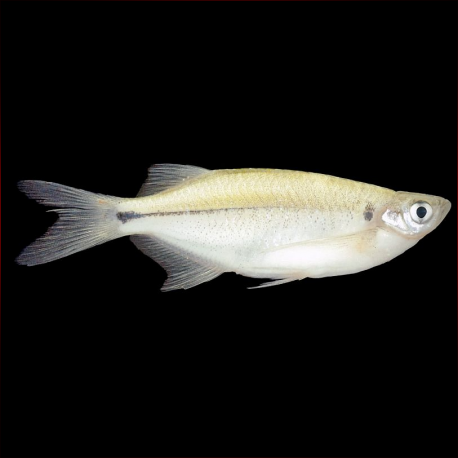More info
Datasheet
| Minimum Tank Size | 160 litres / 42.27 US gallons |
| Maximum Size | 6.0cm / 2.36inches |
| Temperature | 20°C / 68.00°F - 28°C / 82.40°F |
| Hardness | 1.01dgH / 18ppm - 10.03dgH / 179ppm |
| pH | 6.0-7.5 |
General Description
Considered synonymous with the congener L. laubuca for a number of years, thus reports of that species from anywhere in Indochina actually refer to the current concept of L. siamensis. The two species can be distinguished by color pattern, with L. siamensis having a black midlateral stripe on the posterior portion of the body. In live specimens, this stripe is iridescent blue and terminates in an oval-shaped blotch on the caudal peduncle. The fish also possess faint vertical markings on the anterior portion of the body, with a vertically-oriented humeral marking. The genus Laubuka is closely related to other cyprinids according to recent phylogenetic research.
Aquarium Setup
Laubuka Siamensis thrives best in a well-maintained larger aquarium designed to resemble a slowly-flowing river or stream, with a substrate of rocks, gravel, and water-worn boulders. Driftwood branches and aquatic plants such as Microsorum, Bolbitis, or Anubias spp. can be added to mimic its natural habitat. This schooling species should ideally be kept in groups of 8-10 to reduce stress and create a more natural display. The setup also requires spotless water conditions and a tightly-fitting cover due to the fish's jumping ability.
Behaviour
Not an aggressive fish, Laubuka Siamensis can coexist with various fish species like cyprinids, loaches, cichlids, catfish, and characins. It is a schooling fish by nature and is commonly observed swimming in groups at or just below the water surface. Keeping them in a group helps reduce nervousness and enhances the overall natural appearance of their behavior.
Feeding and Diet
Naturally, Laubuka Siamensis is a surface feeder preying on terrestrial and aquatic invertebrates. In an aquarium setting, they accept dried foods of suitable sizes but should also be offered live and frozen foods like Daphnia, Artemia, and bloodworms regularly to ensure a balanced diet.
Reproduction & Dimorphism
Information regarding the reproduction of Laubuka Siamensis is unreported. Adult females of this species are typically deeper-bodied and tend to grow slightly larger than the males.
Habitat and Distribution
Native to the Mekong river system in countries such as Thailand, Laos, Cambodia, and Vietnam, Laubuka Siamensis inhabits small tributary streams, freshwater pools, and canals. They are also known to move into inundated forests during the wet season, preferring quiet water bodies and thriving in groups at the water surface.

